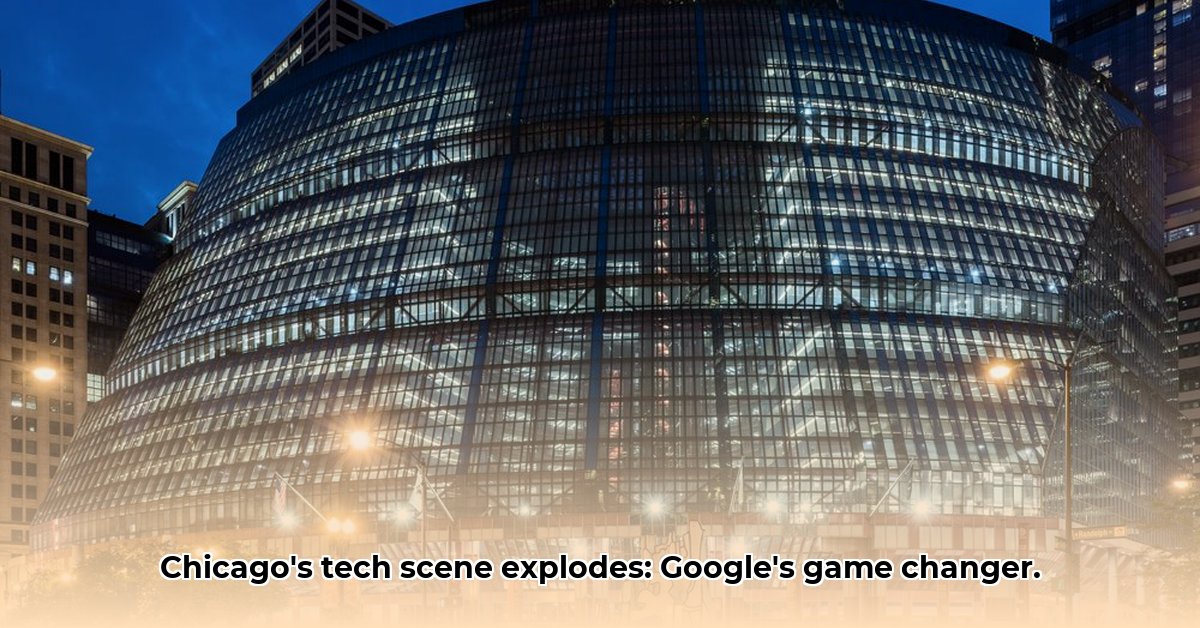Chicago’s James R. Thompson Center (JRTC) is undergoing a significant transformation, evolving from a structure with a complex past into a potential hub of technological innovation. This iconic example of postmodern architecture has garnered both acclaim and criticism, facing challenges ranging from inherent design flaws to exorbitant operating costs. Learn more about Chicago’s iconic symbols by visiting the Chicago flag. Google’s acquisition marks a pivotal moment, offering a vision that balances architectural preservation with modernization and sustainable urban development. This article explores the comprehensive renovation plans, the lessons learned from the JRTC’s history, and the broader implications for Chicago and other cities grappling with similar redevelopment projects.
State of Illinois Building Chicago’s Transformation: Google’s Tech Hub
From Postmodern Icon to Tech Giant’s Playground: The Story of the James R. Thompson Center
The James R. Thompson Center (JRTC) is a recognizable landmark in downtown Chicago. Its soaring atrium, constructed from glass and steel, was intended to symbolize Chicago’s architectural ambition. However, the building struggled with operational inefficiencies, particularly high energy costs stemming from outdated heating, ventilation, and air conditioning (HVAC) systems and single-pane windows. Over time, the building unintentionally became a symbol of government inefficiency and the challenges of maintaining ambitious architectural visions.
The JRTC’s architectural journey has been marked by fluctuating public opinion. Initially criticized for its impractical design and high maintenance demands, it gradually gained appreciation as a unique and visually striking component of Chicago’s urban identity. This shift demonstrates how architectural tastes evolve and how perceptions of a building can change significantly over time.
A New Chapter: Google Steps In
Google’s acquisition of the building represents a significant shift in Chicago’s urban and economic landscape. This move underscores the growing importance of the technology sector in Chicago and the evolving priorities of city planning, which now include attracting and retaining tech companies. A critical question is whether Google can successfully address the building’s inherent flaws while preserving its iconic aesthetic. Google’s commitment to achieving LEED Platinum certification, the highest standard in environmental sustainability, signals a dedication to creating an eco-friendly building, a crucial element for modern urban centers. The renovation is expected to cost $280 million.
Balancing Modernization and Preservation
The JRTC’s renovation requires a delicate balance between modernization and preservation. Google aims to maintain the integrity of the atrium, recognizing its architectural value and its importance as a public space. However, concerns remain regarding the extent of public access and whether the renovated building will primarily serve Google employees or continue to function as a mixed-use space accessible to the broader community. This transformation reflects Chicago’s ongoing evolution as a global city, navigating the complex dynamics between economic investment, historical preservation, and future urban development.
Stakeholders and Their Goals
The JRTC’s transformation impacts numerous stakeholders, each with distinct short-term and long-term objectives:
| Stakeholder | Short-Term Goals (0-1 Year) | Long-Term Goals (3-5 Years) |
|---|---|---|
| Secure necessary permits, initiate renovations, address immediate operational inefficiencies, and manage community relations | Establish a fully functional and sustainable Google office in Chicago, contribute positively to the local economy, and enhance the company’s brand image | |
| City of Chicago | Manage construction impact, ensure regulatory compliance, and mitigate traffic disruptions | Stimulate economic growth, ensure public access to essential services, promote sustainable urban planning, and enhance the city’s reputation as a tech hub |
| Preservationists | Monitor construction activities to ensure adherence to preservation guidelines and advocate for the protection of key historical elements | Ensure the preservation of public areas and significant historical features within the renovated structure, promote awareness of the building’s architectural significance |
| Illinois State Government | Facilitate the smooth relocation of state offices and oversee the financial aspects of the sale | Evaluate the long-term financial outcomes of the sale, assess its impact on state resources, and ensure efficient operation of the new state office building |
| Chicago Residents | Minimize disruption from construction, maintain access to transportation and public spaces | Benefit from economic growth, enjoy accessible public spaces within the renovated building, and see the preservation of a unique architectural landmark |
Lessons Learned and the Future of Urban Redevelopment
The JRTC project imparts valuable lessons about large-scale public endeavors. It underscores the importance of balancing bold architectural designs with practical functionality and highlights the necessity of sustainable building practices. The project also demonstrates the importance of public input and adaptability in the face of changing needs and priorities. According to Block Club Chicago, the results of this project will have a profound effect on future urban planning, influencing how cities approach the renovation and repurposing of older buildings. This project will serve as a valuable case study for urban planners and developers for years to come.
How will Google’s Thompson Center renovation impact public access? Sustainable Urban Regeneration Strategies in Chicago’s Loop
Key Takeaways:
- The Thompson Center transformation promises economic benefits through job creation and increased tax revenue for Chicago.
- Google’s commitment to LEED Platinum certification indicates a strong focus on environmental sustainability and energy efficiency.
- The renovation’s impact on public access and the preservation of public spaces remain significant community concerns.
- Balancing historical preservation with modern needs and ensuring community benefits is critical for the project’s success.
A Landmark’s Makeover: Economic Promises and Uncertainties
The Thompson Center’s renovation is expected to stimulate economic growth, but what are the broader implications for the city and its residents? Google’s investment promises to create thousands of jobs and generate millions in tax revenue for the city. However, there are also concerns about potential displacement of local businesses and the impact on affordable housing in the surrounding area.
Sustainability and Environmental Impact
Google’s dedication to sustainability, aiming for LEED Platinum certification, includes plans for bird-safe facades and fully electric systems. But will these sustainability efforts counteract potential negative impacts, such as increased traffic and strain on local infrastructure? The renovation aims to reduce the building’s carbon footprint and enhance its energy efficiency, setting a new standard for sustainable building practices in Chicago.
The Public Access Question
How will Google’s Thompson Center renovation impact public access to the building’s many public spaces? One of the most debated aspects of the JRTC’s renovation is the future of public access. While Google has committed to maintaining access to the atrium and the CTA station, the availability of other public spaces, such as the food court and community meeting rooms, remains uncertain. The original building served as a vibrant public hub, a role that is important to preserve during the renovation.
Balancing Act: Preservation and Progress
Balancing preservation and modernization presents a major challenge. The building’s iconic atrium will be preserved, reflecting a commitment to architectural heritage. This adaptive reuse approach contrasts with earlier demolition proposals and aims to honor the building’s history and architecture while also incorporating modern amenities and sustainable design features.
Community Concerns and Engagement
Chicago residents are concerned about the potential loss of vital public space and the impact of the renovation on the surrounding community. To ensure the project’s success, Google needs to emphasize open communication and community engagement, seeking public input on the building’s future use and design.
Looking Ahead
The Thompson Center’s transformation highlights key urban challenges and opportunities. It is a test of balancing economic development with social responsibility and ensuring accessible public spaces for all residents. According to Block Club Chicago, the success of the project will ultimately be measured by its contribution to Chicago’s inclusivity, sustainability, and economic vitality.
Sustainable Urban Regeneration Strategies in Chicago’s Loop: Reimagining the Thompson Center
Key Takeaways:
- The Thompson Center renovation signifies a pivotal case study in sustainable urban regeneration, showcasing how to revitalize an aging structure.
- Google prioritizes energy efficiency, waste reduction, and sustainable design principles throughout the renovation process.
- Balancing historical preservation with sustainability goals presents complexities that require innovative solutions and community input.
- Collaboration among stakeholders, including government agencies, community organizations, and private developers, is crucial for successful implementation.
- Continuous monitoring and evaluation of environmental performance are essential for assessing the project’s long-term impact and ensuring accountability.
A Landmark Transformed
The JRTC transformation is more than just a real estate deal; it’s a milestone showcasing sustainable urban regeneration. Google’s renovation offers a chance to reshape the surrounding area’s sustainability profile, demonstrating how to revitalize an existing structure in an environmentally responsible manner.
Sustainability at the Core
Google’s dedication to sustainability includes targeting LEED Platinum certification, implementing energy-efficient technologies, and promoting waste reduction. What does a net-zero energy consumption building mean for the city’s environmental ambitions? The renovation involves upgrading HVAC systems, improving insulation, and potentially integrating renewable energy sources, aiming to significantly reduce the building’s carbon footprint.
Challenges and Opportunities
The Thompson Center’s transformation requires balancing preservation and modernization. What is the balance between honoring the past while creating a sustainable future that meets the needs of the community? This balance necessitates thoughtful architectural planning, community involvement to ensure benefits for local residents, and economic strategies that benefit the wider community.
A Blueprint for the Future?
The JRTC’s revitalization tests Chicago’s approach to sustainable urban regeneration. Will it become a model for other cities facing similar challenges? The project’s success hinges on its ability to balance economic development, environmental sustainability, and social equity.
Preservation of Postmodern Architecture in Chicago Redevelopment Projects
Key Takeaways:
- The James R. Thompson Center represents both significant opportunities and
















